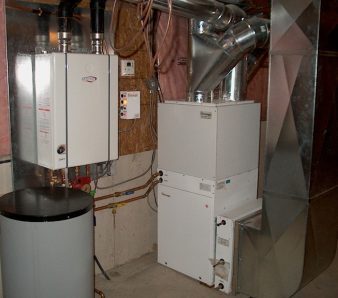What can you do to maintain your forced air furnace?
Some simple maintenance will keep your forced air furnace operating smoothly. Make sure you shut off the electricity to the furnace before you take off the access panel.
Replace the air filters regularly
As you can imagine, clogged filters are going to slow down the flow of warm air through your house. Some experts recommend replacing the filters every month. If you have a permanent filter (made of plastic or aluminum), you can just wash and reuse it. Electrostatic air filters contain polyurethane and polypropylene fibers, and actually act like a magnet to attract dust, mold, and other airborne particles. These are generally quite a bit more expensive than a disposable filter, last a long time, and should be vacuumed or washed often. Check the manufacturer’s instructions before cleaning.
Check for leaks
Check the ductwork to make sure warm air isn’t escaping through cracks or holes before it gets to your living areas. There are many different ways to do this. This Old House has a video which shows you a few ways, including how to use a smoke pencil to locate leaks. You can then make repairs in any accessible areas, using duct mastic in rough areas or places with sharp edges. The Green Building Advisor describes mastic as “a gooey, non-hardening material with a consistency between mayonnaise and smooth peanut butter.” At smooth joints, instead of mastic, people often wrap duct tape around the ductwork to prevent leaks. However, experts advise not to use standard cloth backed “duct” tape as it will come loose over time. Instead, use foil-faced duct tape.
Check the fan
If you have a direct-drive fan, you may just need to vacuum it. If there is a fan belt involved, get a service technician to check the tension.
Remove any obstructions
Check around the cold air intakes and the heat registers, to make sure they’re not being obstructed by furniture or draperies.
What is the life expectancy of a forced air furnace?
The life expectancy of a good quality forced air furnace is about 15 years. After that time, the seals and the fan motor start to wear out. Of course, proper maintenance and the replacement of any worn parts have a bearing on the life expectancy of the furnace.
Like most heaters, some experts recommend that you have a certified service technician check your furnace each year to make sure it’s not losing warm air before it gets to the ductwork. They will also check the heat exchanger, flame sensor, pilot light, fan, and motor.
What will your home insurance provider want to know?
Your home insurance provider may want to know the age and type of furnace in the house, as well as the type of fuel. Once a furnace has passed its life expectancy, not only may it operate less efficiently, causing your energy bill to go up, but it could break down, or the pilot light may go out, which could cause serious freezing issues if it happens in the middle of winter.
Keeping your furnace well maintained, and in good repair, will help you, and your insurance company, rest easy.
Commonly asked questions
What is the difference between central heating and forced air?
These two terms can be used interchangeably, as they are simply different ways of referring to the same heating process. There is a big difference if the term you’re using is central air, however, as this instead specifically alludes to air conditioning systems.
How much will a new furnace system cost?
Most homeowners can expect to pay between $2,500 and $5,000 CAD to install a forced air furnace in their home. Prices can vary greatly depending on the specifics of the system you plan to install and the overall build of your house, however, so be sure to research diligently before committing to a purchase.
Is forced air heating gas or electric?
Forced air furnaces come in a variety of options, including not only gas and electric but also propane, oil, and other alternatives. You can inspect your furnace for gas lines or electrical wiring to discover for yourself what type is installed in your home, but be cautious not to tamper with the pilot light, wiring, or any other important or hazardous materials.
Is forced air heating more efficient than radiant heating?
According to the U.S. Department of Energy’s Energy Savers website, properly installed and maintained radiant heating is more efficient than comparable forced air. The difference primarily comes from the immediate range of radiant heat, which can radiate directly into a room and therefore loses less heat than forced air does as it travels through your home’s ducts.
Want to learn more? Visit our Getting to Know Your Home resource centre for the complete rundown on all your home's systems and features. Or, get an online quote in under 5 minutes and find out how affordable personalized home insurance can be.
About the expert: George Baral
George Baral has an MBA and a masters' degree in chemistry. He spent almost 35 years inspecting and evaluating heating and air conditioning systems before retiring. He obtained a California general contractor's license to start a company focusing on energy-efficient construction, became certified as a LEED AP and earned a NATE (North American Technical Excellence) certification, which provides advanced training for HVAC technicians.


